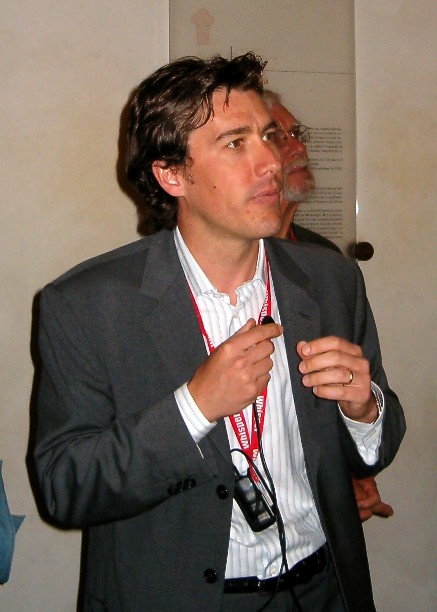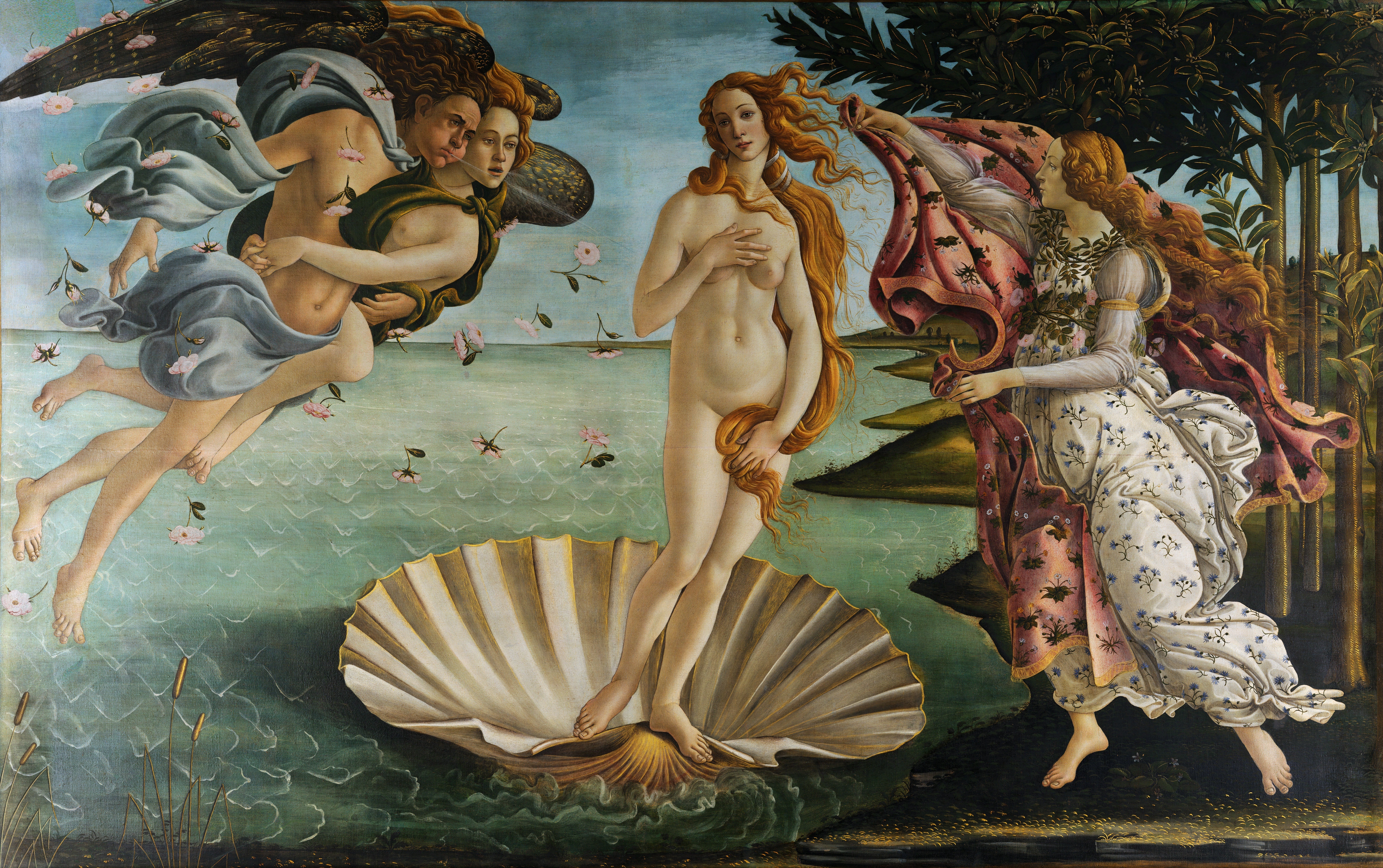|
We wanted to get an early start in order to beat the crowds, so breakfast was moved up an hour to 7:00. Our companions included Dick and Joyce Hall (CA), John and Susan Jewett, and two others (can't read my own handwritten notes!). The bus left for Pisa at 8:00. It was foggy, but the sun broke through by the time we passed Lucca.
Pisa lies near the mouth of the Arno River. It was an early leader in Italian trading activities in the western Mediterranean, principally in the silk trade. Its chief rival was Genoa and two cities fought each other vigorously throughout the 13th century (Pisa lost in the 14th). During its heyday, Pisans built the Campo dei Miracoli (Field of Miracles), the only part of town we intended to visit.
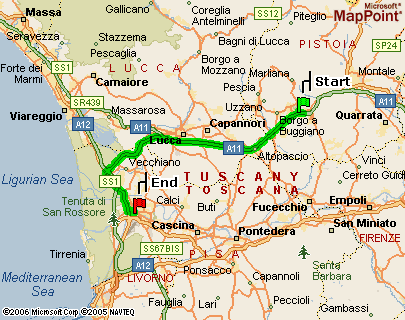
Pisa: 33.7 miles, 39 minutes
| 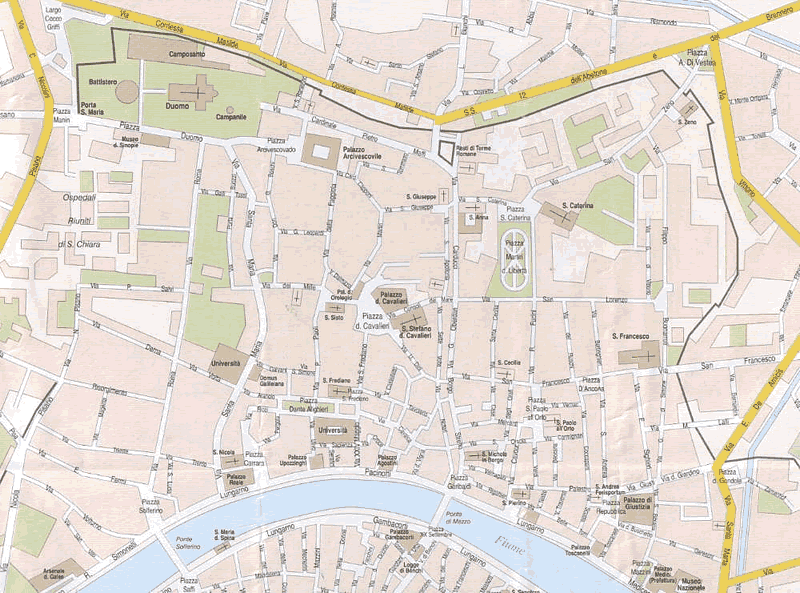
| 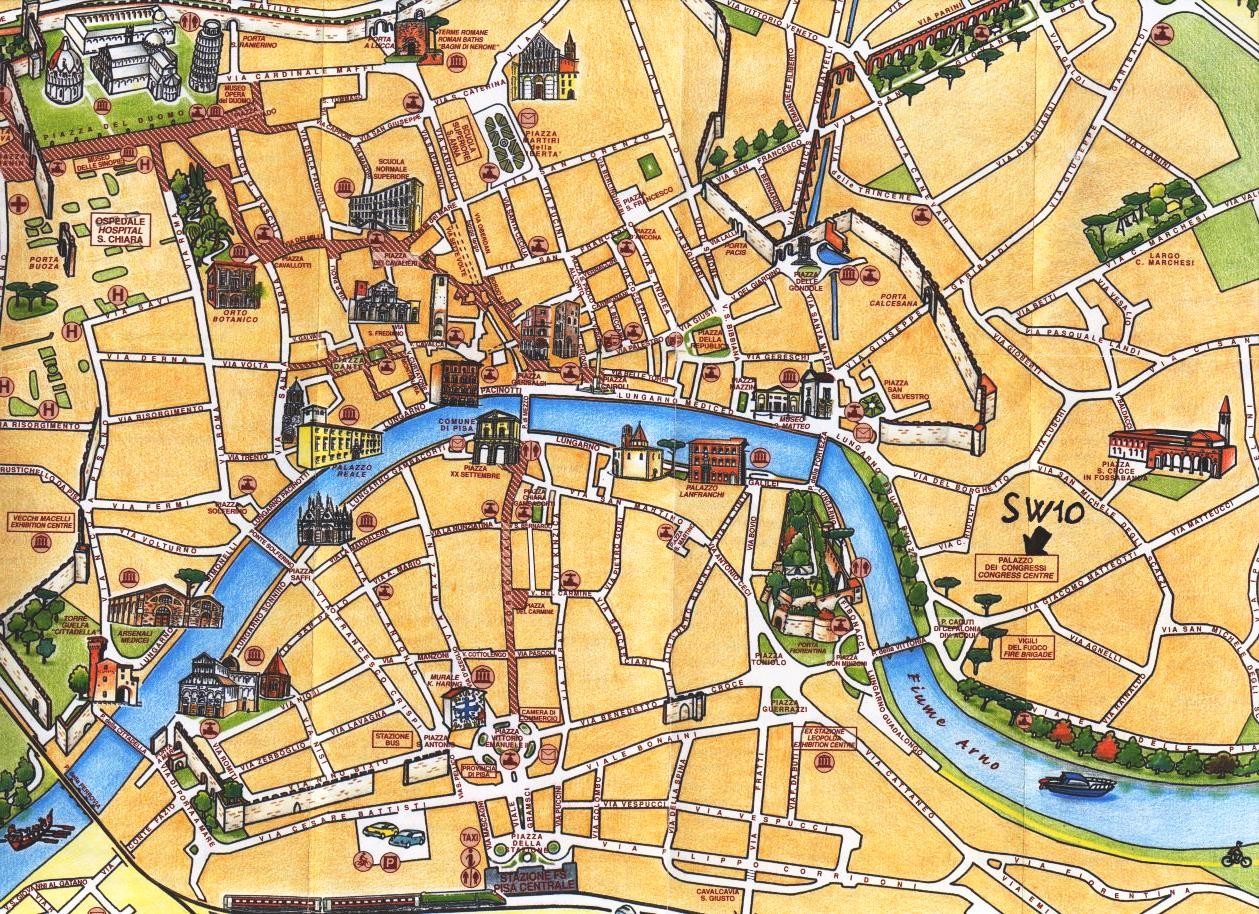
|
| Comune di Pisa | Provincia di Pisa |

|
| Province | Pisa (PI) |
| Elevation | 4 m |
| Area | 185 km² |
| Population ('05) | 90,482 |
| Density | 462/km² |
| Time zone | CET, UTC+1 |
| Coordinates | 43°43' 10°24' |
| Dialing code | 050 |
| Postal code | 56100 |
| Patron | San Ranieri, 17 June |
 |

|
|
Campo dei Miracoli
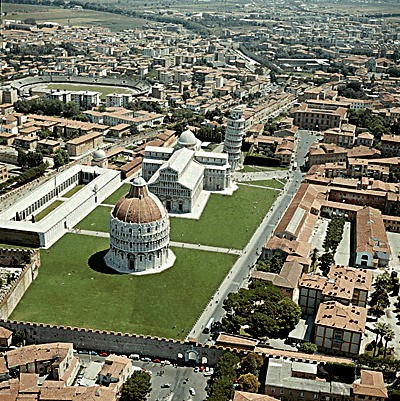 |
 | |
| "La Porta della Mala Fortuna" |
The campo contains four major buildings within an ancient wall, the crenellations of which can be seen in the picture to the left). Entry is through an arch in that wall. It was there that I made the mistake of looking up in awe at the magnificent buildings when I should have been looking down at the curb. (As I type this I'm reminded vaguely of Raphael's Scuola di Atene, The School of Athens; I was obviously following Plato when I should have obeyed Aristotle.) I sensed myself tripping over that curb as if it were slow motion and I had all the time in the world to think about the process. I remember losing my balance and trying to take little running steps to compensate, as in a Warner Brothers cartoon. Then I remember coming down very hard on my right knee, then my left wrist. For a moment I thought that I had come to a rest, but I next sensed almost an external force pushing down on my head, slamming my face on the regionally famous pietraforte (literally hard stone) of the sidewalk.
I picked myself up and realized I had not twisted an ankle or broken any bones, but then discovered I had a rather profuse nosebleed, augmented by the blood thinners I take because of my artificial heart valve. Sabrina rushed over with tissues which I went through rapidly. The group went on, and Karen and I stood in the Piazza (the road running alonside the Campo) while Sabrina went to get bandages and cortizone cream. I later saw that I had seven major scrapes on my nose and forehead. I must've been somewhat in shock because I don't recall anything hurting all that much, though I did feel woozy and punchdrunk and had a dull headache. Sabrina led me to a caffé which had a restroom where I could wash up. I still needed to hold a tissue to my nose for quite some time. Sabrina or Christine christened the archway I tripped through "La Porta della Mala Fortuna" which is certainly how I'll always think of it.
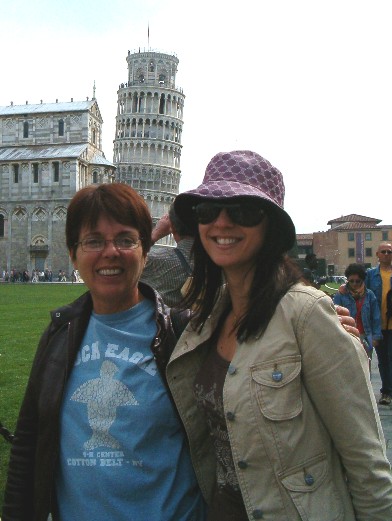
Sabrina Lanzoni
with Christine | |
After I don't know how long, we rejoined the group. They had just left the most famous site in the Campo, the Torre Pendente di Pisa, the Leaning Tower of Pisa. This excellent website offers a gallery of 6,400 photographs of the site; every column, capital and decoration of the tower is accurately photographed and catalogued. There is also a complete history, along with information on the inclination and the restoration interventions. Our tour guide in Pisa was Sabrina Lanzoni. She was very funny whenever she would whisper a mock loathing for Firenze (Florence): Fee-RAAAYN-zzzzeeee. With all the centuries-old inter-city rivalries in this part of the world, everyone seems to delight in dumping on Pisa, so this was a bit of payback. Unfortuantely I didn't get a picture of Sabrina. Fortunately, Laura Papallo got one of Sabrina and Christine seen to the left, as well as sending the picture of Kirk Duclaux below (Thanks, Laura).
There's no way I can compete with the photos of this much-photographed place, so I'll just include a few personal snapshots. In the first, we've just rejoined the group (that's Karen in the striped sweater and straw hat). We're standing in front of the Torre, beside the Duomo (Cathedral), looking toward the Battistero (Baptistry). The second picture shows a statue of an Etruscan lion on top of part of the original wall which guarded the city (note the "porta leone"), along with a corner of the Camposanto (Cemetery). The Cemetery was severely damaged by the German and American bombs during WWII (it was located too near the railroad station). The picture below shows some of our group examining ongoing fresco repair/restoration. The Cathedral is gorgeous inside (one of the few which allow pictures). There's grass all over the Campo -- kind of surprising to come across such an expanse of lawn -- but the one which Karen is standing beside is the only one with signs posted to "keep of the grass". Apparently they wanted at least that portion free of tourists, who jam this place in the summer (6 million a year). As I turned around from taking that picture and headed back toward that fateful arch through which we entered, I saw that piccioni (pigeons, though a gruff man in Padua insisted that I called them colombe, doves) were nesting in the holes in the Etruscan-Roman wall, holes which were originally used to support the scaffolding used in their construction.
Here is Rick Steves' quickie take on Pisa. And here are a bunch of (moving) panorama shots at eye level.
Renaissance Painting
|
We returned to the hotel for lunch. Our companions were Rich Flower (CA), Bill and Carol McCartey (ID), and Kjeld and Karen Husebye (MN).
At 3:00 we were given a double lecture on Renaissance painting by one of our favorite guides, Kirk Duclaux, whom we enjoyed in Venice a year and a half ago. Amazingly, he remembered us -- when he walked into the room he greeted us as if we'd just parted yesterday. Kirk is as handsome as he was then, and now has a second baby boy (expected when last we met). His topic was the evolution from the flatness of the Byzantine to the full perspective of the Renaissance. He argued that the flatness was in a sense merely a convention (i.e., they knew things didn't look that way), but that it also re-enforced religious belief: namely, the sacred was "different" from the profane. While he was talking I thought about all those angels walking around and bumping halos. He noted that if you remove the halos, they are in fact standing unnaturally far apart from one another.
Kirk dwelt on one painting in particular, the first example of a calculated perspective with a single vanishing point, Masaccio's Trinity (between 1425 and 1428), which we later saw at the Santa Maria Novella in Florence (I'm resisting the temptation to hiss the city's name, a la Sabrina this morning). Apparently, in spite of the obvious, people believed the vanishing point lay in Christ's head, or heart, or belly button. It's clearly where the cross touches Earth. Kirk showed us how you can calculate the depth of that room behind the crucifix by the diminishing rosettes in the ceiling (see also the first drawing here). According the Web Gallery website, the writing above the skeleton says "I WAS WHAT YOU ARE AND WHAT I AM YOU SHALL BE". Kirk spent some time on Botticelli, too, but I was already familiar with him; I was really fascinated by Masaccio. There's an interesting pair of videos showing the room reconstructed in 3-D (go here and search for "3D").
Here's what the Syracuse University website says of our guide: Kirk Duclaux is an Art Historian living in Florence, Italy with his wife and two sons. He received his undergraduate degree in Art History from the University of Cincinnati 's College of Design, Art, Architecture and Planning and his graduate degree from Syracuse University 's Program in Renaissance Art History in Florence, Italy . In retrospect, it's no wonder Kirk finds himself in Florence educating all sorts of travelers and students about art. At most points in his adult life he has been an educator. From teaching immigrants in Cincinnati, to teaching children with autism in Chicago; as a lecturer with Syracuse and Vanderbilt Universities to his role as guide for the American Embassy in Rome and the American Consulate in Florence, Kirk considers himself lucky to have had the chance to meet a fascinating array of people. Most recently, Kirk developed a study abroad program for The University of Oklahoma where he is Director of Italian Studies in Tuscany in Arezzo, Italy.
At 6:00 we had a "Florence prep" session from Sabrina, in preparation for our trip to that city tomorrow. After that Christine ran through "Survival Italian". After that we had a very pleasant dinner with Kjeld and Karen Husebye (MN), Sue Degan and Joan Rearick (IN), Howard Meeks (FL), and Gloria Valone (CO, formerly Seattle WA). We ended the evening with lovely walk in the neighborhood.
|
INDEX - PREV - NEXT
|
|















